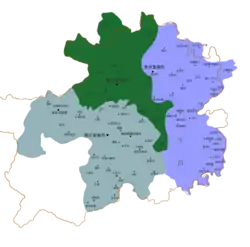Chiefdom of Bozhou 播州土司 | |||||||||
|---|---|---|---|---|---|---|---|---|---|
| 876–1600 | |||||||||
 Chiefdom of Bozhou | |||||||||
| Status | Native Chiefdom of China | ||||||||
| Capital | Bozhou (present day Zunyi) | ||||||||
| Common languages | Nasu, Chinese, Gelao, Hmong | ||||||||
| Government | Monarchy | ||||||||
| Chieftain | |||||||||
• 876–? | Yang Duan (first) | ||||||||
• 1595–1600 | Yang Chaodong (last) | ||||||||
| History | |||||||||
• Established | 876 | ||||||||
| 1600 | |||||||||
| |||||||||
| Today part of | China | ||||||||
The Chiefdom of Bozhou (Chinese: 播州土司; pinyin: Bōzhōu Tǔsī), ruled by the Yang clan, was an autonomous Tusi chiefdom established by Yang Duan (楊端) during the Tang dynasty. After he conquered the Bozhou Prefecture (centred on modern Zunyi) from the Nanzhao Kingdom, Yang Duan was recognized as the hereditary ruler of the region by the Tang court in 876.
The Yang clan ruled Bozhou for more than seven centuries, surviving several dynastic changes in China, until its last ruler Yang Yinglong rebelled against the Ming dynasty in 1589. It took more than a decade for the Ming to suppress the rebellion, and the Bozhou Tusi was defeated and abolished in 1600.[1][2][3][4]
Bozhou, Sizhou, Shuidong and Shuixi were called "Four Great Native Chiefdom in Guizhou" (贵州四大土司) by Chinese.[5] "Liangguang [ruled by] Cen and Huang, Sizhou and Bozhou [ruled by] Tian and Yang" (Chinese: 两广岑黄,思播田杨; pinyin: Liǎngguǎng Cén Huáng, Sī Bō Tián Yáng), an idiom current among Southwestern Mandarin speakers, proved that the Yang clan was once one of the most powerful clans in Southwestern China.[6]
History
The Chiefdom of Bozhou was established in 876 when the first chieftain Yang Duan occupied Bozhou (modern-day Zunyi) in southwest China. It lasted for about 725 years over 29 generations through the Tang, Song, Yuan, and Ming dynasties. The main fortress of Bozhou was Hailongtun, constructed in 1257. About 17,000 Bozhou soldiers who were led by the 29th Chieftain Yang Yinglong (楊應龍) fought against the 240,000 Ming Dynasty for 114 days. In the end the Tusi force was defeated and Yang Yinglong was killed. The Ming Dynasty burned down Hailongtun, and put an end to the 725 years rule of the Yang Family.
List of Bozhou Chieftains
Below are Bozhou chieftains[7][8][9]
| No. | Name | Chinese | Reign | Notes |
|---|---|---|---|---|
| 1 | Yang Duan | 楊端 | 876–? | |
| 2 | Yang Munan | 楊牧南 | ?–? | son of Yang Duan |
| 3 | Yang Bushe | 楊部射 | ?–? | son of Yang Munan |
| 4 | Yang Sangong | 楊三公 | ?–? | son of Yang Bushe |
| 5 | Yang Shi | 楊實 | ?–? | son of Yang Sangong |
| 6 | Yang Zhao | 楊昭 | ?–? | son of Yang Shi |
| 7 | Yang Guiqian | 楊貴遷 | ?–1052 | adoptive son of Yang Shi descendant of Yang Duan |
| 8 | Yang Guangzhen | 楊光震 | ?–? | son of Yang Guiqian |
| 9 | Yang Wenguang | 楊文廣 | ?–? | son of Yang Guangzhen |
| 10 | Yang Weicong | 楊惟聰 | ?–1125 | son of Yang Wenguang |
| 11 | Yang Xuan | 楊選 | 1125–1155 | son of Yang Weicong |
| 12 | Yang Zhen | 楊軫 | ?–? | son of Yang Xuan |
| - | Yang Shi | 楊軾 | ?–? | co-ruler of Yang Zhen son of Yang Xuan |
| 13 | Yang Can | 楊粲 | 1201–1233 | adoptive son of Yang Zhen son of Yang Shi |
| 14 | Yang Jie | 楊价 | 1233–1243 | son of Yang Can |
| 15 | Yang Wen | 楊文 | 1243–1265 | son of Yang Jie |
| 16 | Yang Bangxian | 楊邦憲 | 1265–1281 | son of Yang Wen |
| 17 | Yang Hanying | 楊漢英 | 1281–1316 | also known as Yang Sayin-buqa (楊賽因不花) son of Yang Bangxian |
| 18 | Yang Jiazhen | 楊嘉貞 | ?–? | also known as Yang Yanli-buqa (楊延禮不花) son of Yang Hanying |
| 19 | Yang Zhongyan | 楊忠彥 | ?–? | son of Yang Jiazhen |
| 20 | Yang Yuanding | 楊元鼎 | ?–1370 | son of Yang Zhongyan |
| 21 | Yang Keng | 楊鏗 | 1370–1399 | descendant of Yang Bangxian |
| 22 | Yang Sheng | 楊昇 | 1399–1441 | son of Yang Keng |
| 23 | Yang Jiong | 楊炯 | 1441–1442 | grandson of Yang Sheng |
| 24 | Yang Gang | 楊綱 | 1442–1449 | son of Yang Sheng uncle of Yang Jiong |
| 25 | Yang Hui | 楊輝 | 1449–1474 | son of Yang Gang |
| 26 | Yang Ai | 楊愛 | 1474–1497 | son of Yang Hui |
| 27 | Yang Bin | 楊斌 | 1497–1520 | son of Yang Ai |
| 28 | Yang Xiang | 楊相 | 1520–1543 | son of Yang Bin |
| 29 | Yang Lie | 楊烈 | 1543–1571 | son of Yang Xiang |
| 30 | Yang Yinglong | 楊應龍 | 1571–1595 | son of Yang Lie |
| 31 | Yang Chaodong | 楊朝棟 | 1595–1600 | son of Yang Yinglong |
References
- ↑ Chinese Tsui Culture Added to The World Heritage List: finanznachrichten.de (07-Apr-15)
- ↑ The legendary Yang clan: hailongtun.com Archived 2017-02-11 at the Wayback Machine
- ↑ The last battle: hailongtun.com Archived 2017-02-11 at the Wayback Machine
- ↑ Hailongtun – the Demise of a Tusi Lord: chinascenic.com Archived 2017-11-16 at the Wayback Machine, retrieved 5 Mar 2017
- ↑ 颜丙震 (June 2018). 明后期黔蜀毗邻地区土司纷争研究 (in Chinese). ISBN 9787511555625.
- ↑ "思州土司的前世今朝:田氏传奇八百年 土司文化传后代" (in Chinese). people.com.cn.
- ↑ 《明通鉴》卷6
- ↑ 陈季君, 党会先, 陈旭, 《播州土司史》, 中央民族大学出版社, 2015, 308 pages
- ↑ 播州杨氏土司世系表, retrieved 23 Jun 2019